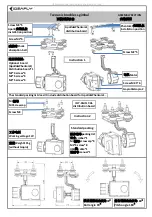
5
OPERA
OPERA
OPERA
OPERA
OPERATING INSTR
TING INSTR
TING INSTR
TING INSTR
TING INSTRUCTIONS
UCTIONS
UCTIONS
UCTIONS
UCTIONS
To assist in the awning setup, locate the legs to the ground
after approximately 3-feet of the canopy is extended. This
reduces any strain on the walls/brackets of the vehicle.
(FIG. 9)
T
T
T
T
TO OPEN
O OPEN
O OPEN
O OPEN
O OPEN
1. Place the hook of the crank into the eye of the gear and
completely unroll the awning.
The awning will be fully extended when fabric starts to
sag. After this occurs, roll awning back 1/4 turn to reach
maximum tension.
2. Loosen the lock knobs on the support arms and slide
each arm away from the center of the lead rail. Swing
each arm downward to the ground. (FIG. 10)
3. For car port position
car port position
car port position
car port position
car port position,
stake the support arms
to the ground with stakes
provided. (FIG. 11)
FIG. 9
FIG. 9
FIG. 9
FIG. 9
FIG. 9
FIG.10
FIG.10
FIG.10
FIG.10
FIG.10
For patio position,
engage the support
arm foot into the bot-
tom mounting brack-
et. (FIG. 12)
4. Roll up the awning a
little - until the fabric
is taut.
FIG. 12
FIG. 12
FIG. 12
FIG. 12
FIG. 12
T
T
T
T
TO CLOSE
O CLOSE
O CLOSE
O CLOSE
O CLOSE
1. Loosen the black knob and slide the support arms
completely together.
2. Place the hook of the crank into the eye of the gear and
roll awning up, to within 3-feet of being closed.
3. Rotate the support arms upward and place then under
the closing plate of the lead rail. Tighten the knobs.
4. Finish rolling up awning. Case is self-locking.
Fabric must roll around roller tube from bottom of
Fabric must roll around roller tube from bottom of
Fabric must roll around roller tube from bottom of
Fabric must roll around roller tube from bottom of
Fabric must roll around roller tube from bottom of
roller tube. Make sure the awning is correctly closed
roller tube. Make sure the awning is correctly closed
roller tube. Make sure the awning is correctly closed
roller tube. Make sure the awning is correctly closed
roller tube. Make sure the awning is correctly closed
by observing the red indicators at either end of the
by observing the red indicators at either end of the
by observing the red indicators at either end of the
by observing the red indicators at either end of the
by observing the red indicators at either end of the
awning.
awning.
awning.
awning.
awning.
OTHER OPERATION NOTES
OTHER OPERATION NOTES
OTHER OPERATION NOTES
OTHER OPERATION NOTES
OTHER OPERATION NOTES
1. To resist unexpected gusts of wind, it is always best to
set awning support arms into the pivot position. If car
port position is to be used, be sure that the awning feet
are properly staked into the ground. For further protec-
tion we recommend the ends of the awning lead rail be
tied with straps (not provided) and staked to the ground.
2. If heavy wind conditions exist, retract awning and
If heavy wind conditions exist, retract awning and
If heavy wind conditions exist, retract awning and
If heavy wind conditions exist, retract awning and
If heavy wind conditions exist, retract awning and
place in storage position!
place in storage position!
place in storage position!
place in storage position!
place in storage position!
3. Light-Rain Release Setting: Lower one side of the
awning so that the water can drain off. (FIG. 13, Page
6)
4. 12 ft. – 16 ft. awnings come with a center tension rafter.
Install as shown in FIG. 14, Page 6.
5. The storage bracket is supplied for crank assembly.
(FIG. 15, Page 6).
6. Crank assembly can be shortened as shown in FIG. 16.
3 ft.
1
2
3
FIG. 11
FIG. 11
FIG. 11
FIG. 11
FIG. 11
1
2
3
























